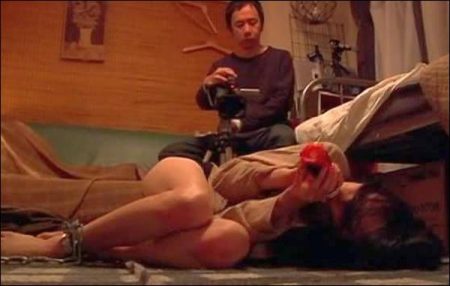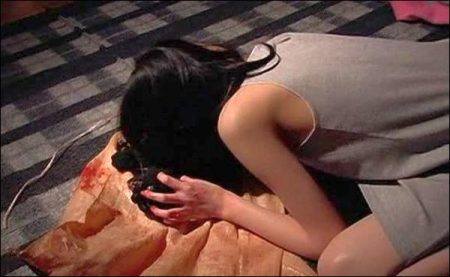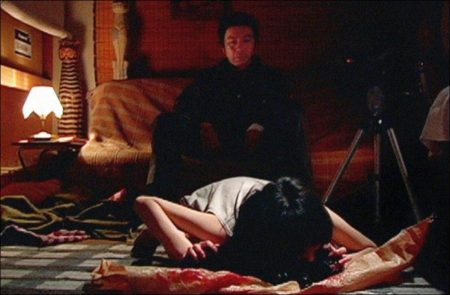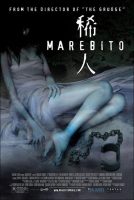Tagline: Fear is just below the surface.
Surrealistic vampires haunt Tokyo’s subway system. A cameraman intrigued by the circumstances surrounding a gruesome suicide is drawn onto a journey beneath Tokyo in search of the spirits reportedly haunting the subways. This latest exercise in Japanese horror from the director of “The Grudge” takes its grainy, digital video cues into Lovecraftian territory.
Masuoka is a cameraman possessed by the craving to understand fear–what it is and where it ultimately leads. He wanders the Tokyo streets, a voyeur, hungrily looking for clues. Obsessing over the haunted expressions of the faces he has captured in his daily filming, in particular a man who committed a grisly suicide on the metro.
He returns to the scene to better comprehend the dead man’s reasoning. Following his final gaze leads Masuoka to a door, an entry into a bizarre, cavernous underworld. Here among the ghosts and the subterranean robots called Dero’s he finds a beautiful young girl chained to a rock. Saving her from her imprisonment he takes her home.
But watching her from his web-cam at work each day he begins to suspect there is something truly inhuman about this girl with sharp teeth and who walks on all fours. When he begins to uncover her horrifying secrets Masuoka realises that he has found the key to gaining the terrible knowledge he so craves…
The Reports on Underground Entrances
Level 1: Shun Akiba
Shun Akiba, once one of Japan’s more respected journalists, now finds himself on some kind of invisible blacklist. His book – ”Teito Tokyo Kakusareta Chikamono Himitsu” – Imperial City Tokyo : Secret of a Hidden Underground Network, published in 2002 is the reason.
Shun claims to have evidence of a network of tunnels and possibly an underground city beneath Tokyo that the public is totally unaware of. It all began when Shun compared an old, discarded map of the Japanese underground system with a current map and found a discrepancy in the direction of two tunnels. He set out to find out the reason and realized this inconsistency is just the first of many differences he unearthed.
The bulk of Shun’s book covers the development of the subway system and questions the many inconsistencies between maps of the past and present–even those that were contemporaneous. According to Shun, ”Even Allowing for errors, there are too many oddities.”
”Every city with a historic subterranean transport system has secrets.” He says. ”In London, for example, some lines are near the surface and others very deep, for no obvious reason. Tokyo is said to have 12 subways and 250 km of tunneling. I’d say that last figure is closer to 2,000 km.”
Whether these omissions and irregularities are because of military, transit or other issues, no one is saying and Shun continues to search for clues.
Level 2: Strange Theories, Stranger Encounters
Richard Shaver isn’t the only person to claim they have proof of underground cities and beings. People far more respected have made similar claims as well, including: Jules Verne, Edgar Allan Poe, 17th century English astronomer Edmund Halley and others wrote about how planet Earth is a hollow sphere.
American authorities had prepared a special scientific mission in 18th and 19th centuries to explore the Earth’s hollow depth.
The Nazis were very interested in the mysterious underground world. A top secret expedition was organized in 1942. Unfortunately, the outcome of the intrigue is not known.
In 1963, two American coal miners found a large door in a tunnel, behind which they discovered a marble stairway. An English miner claims that he found a stairway to an underground well. A sound of machines became distinct from behind the well the closer he got, and he fled in fear. When he returned to the tunnel, there were no stairs and no entrance to the well.
In the late 1970’s, an American satellite took very interesting photographs depicting a dark, regularly shaped spot on the North Pole. Similar pictures depicting the same dark spot on the pole were taken several years later.
During the exploration of a cave in Idaho. Anthropologist James McKenna and other members of the expedition could hear screams as they were moving hundreds meters deep into the cave. As they continued to explore, the researchers found human skeletons but they had to stop their quest: the smell of brimstone was unbearable.
Level 3: The Shaver Theory
Few people today remember Richard Shaver. In the late forties, though, Shaver created a stir with a story printed in Amazing Stories magazine. He claimed our world was honeycombed with huge underground caverns built long ago by aliens from another galaxy. When these beings fled to escape the radiation of our aging sun, their castoffs degenerated into evil dwarves Shaver called ”dero” short for detrimental robots.
These Dero still lived in the cave cities, according to Shaver, kidnapping surface-dwelling people for meat and using the fantastic ”ray”machines that the great ancient races left behind to project tormenting thoughts and voices into our minds. Shaver insisted he’d visited these primeval caverns, and poured forth his exploits and assertions in a stream of stories and articles. Between 1945 and 1949, letters poured in attesting to the truth of Shaver’s claims (tens of thousands of letters, according to Amazing Stories editor Ray Palmer): the correspondents, too, had heard strange voices or encountered denizens of the hollow Earth. But many in the community of science fiction fans publicly condemn the Shaver Mystery as ”the Shaver Hoax.”
Takashi Shimizu (Writer, Director)
A native of Maebashi City, Japan, Shimizu studied drama at Kinki University before enrolling in film school in Tokyo; he subsequently found work as an assistant director in film and video as the millennium drew to a close. Enrolling in a night class in film production, the burgeoning filmmaker began studying under respected Japanese filmmaker Kiyoshi Kurosawa (whose films Cure and Kairo are considered modern Japanese horror classics by many genre fans). When it came time for the students to turn in their three-minute film at the end of the semester, the professor took a special shine to Shimizu’s unusually frightening short.
Impressively establishing a formidable air of dread within the restrictive confines of a brief running time, the film eventually resulted in Kurosawa introducing Shimizu to a Kansai-TV producer — who just so happened to be preparing a 90-minute television horror anthology. Though the producer was indeed impressed with Shimizu’s talent, the new director’s lack of experience proved something of a complication, and instead of helming a 30-minute segment, he was asked to prepare two three-minute shorts for Gakkô No Kaidan G. The shorts offered something of a prequel to Shimizu’s eventual Ju-on series, and in the following year, the director would compile numerous elements of multiple scripts he had written over the years into a frightening release for the lucrative Japanese straight-to-video market.
Released in early 2000, the original Ju-on terrified audiences with its clever use of misdirection, terrifying pale-skinned ghosts, and unearthly use of sound. A sequel was quick to follow later that same year, while the 2001 film Tomie: Rebirth (the third in a continuing series of film adaptations of Junji Ito’s popular manga) offered Shimizu his feature debut.
By then, there was little question that Shimizu was competent in taking the reigns for a feature, with the obligatory film Ju-on: The Grudge (2003) serving as his sophomore theatrical release. Though it didn’t open to the wild success that some may have expected or anticipated, its sequel, Ju-on: The Grudge 2 — released later the same year — offered enough scares to prove that the series still had potential for a lucrative franchise. When word arrived in 2003 that filmmaker Sam Raimi had acquired the rights to an American remake, with series founder Shimizu once again at the helm, anticipation for a seriously terrifying fright film shot to stratospheric levels among genre fans worldwide. The end result, The Grudge, ended up grossing $110M in the U.S. and was immediately green-lit for a sequel.
Shimizu is currently in wrapping up production on his latest film, Rinne, before starting work on Ju-On: The Grudge 3 and The Grudge 2, respectively.
Marebito (2005)
Directed by: Takashi Shimizu
Starring: Shinya Tsukamoto, Shun Sugata, Kazuhiro Nakahara, Tomomi Miyashita, Miho Ninagawa, Junko Amagi, Masayoshi Haneda, Ayumu Saitô
Production Design by: Atsuo Hirai
Cinematography by: Tsukasa Tanabe
Film Editing by: Masahiro Ugajin
Costume Design by: Kuniko Hôjô
Music by: Toshiyuki Takine
MPAA Rating: R for strong bloody violence and some nudity.
Distributed by: Tartan Films
Release Date: December 9, 2005
Visits: 89






